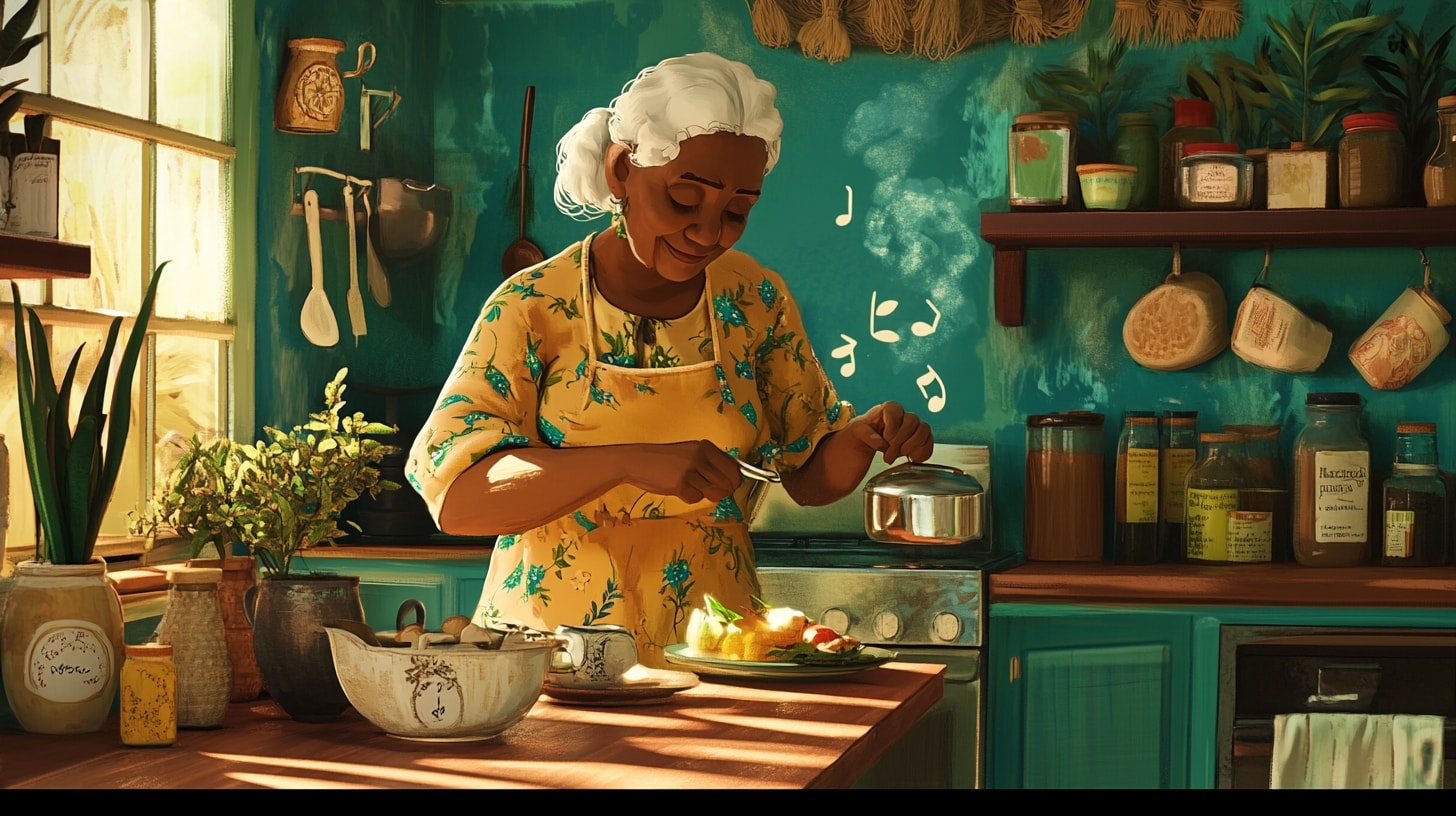Table of Contents
ToggleColic Cures: Caribbean Magic Meets Modern Marvels for Peaceful Nights
Alright, my fellow sleep-deprived warriors, gather ’round for some real talk about the beast we call colic. If you’re reading this, chances are you’ve got a tiny human who’s decided that sleep is for the weak and screaming is an Olympic sport. Trust me, I’ve been there – knee-deep in dirty diapers, hair unwashed for days, and wondering if I’ll ever sleep again. But fear not! We’re about to dive into a magical world where traditional Caribbean wisdom meets modern parenting tricks, and maybe – just maybe – we’ll all come out the other side with our sanity intact.
Now, before we get into the nitty-gritty, let me paint you a picture. Picture a warm, breezy evening in Jamaica. The smell of jerk chicken wafting through the air, the sound of reggae in the distance, and… a baby wailing at the top of their lungs. Yep, colic doesn’t discriminate – it’ll find you whether you’re in a high-rise in New York or a beach shack in Montego Bay. But here’s the kicker: our Caribbean grandmothers have been dealing with this mess for generations, and they’ve got some tricks up their sleeves that’ll make you say Wha gwan? (That’s What’s going on? for the uninitiated).
So, buckle up, buttercup. We’re about to embark on a journey that’ll take us from the sun-soaked shores of the Caribbean to the cutting edge of modern baby-soothing technology. By the time we’re done, you’ll be armed with an arsenal of colic-fighting weapons that would make even the crankiest baby think twice about their next crying session. Let’s dive in, shall we?

The Colic Conundrum: What’s Really Going On?
First things first, let’s talk about what we’re actually dealing with here. Colic isn’t just your average baby cry – oh no, it’s like your little one decided to channel their inner heavy metal singer and go on a world tour in your living room. But what’s really happening under all that noise?
Here’s the deal: colic is basically a fancy term for We have no freaking clue why this baby won’t stop crying. Helpful, right? Doctors define it as crying for more than three hours a day, at least three days a week, for at least three weeks. It’s like the baby version of a marathon, except instead of running, they’re exercising their lungs and your patience.
Now, I remember when my little girl, Zuri, hit her colicky phase. It was like someone had flipped a switch. One day she was this adorable, cooing bundle of joy, and the next she was auditioning for the role of air raid siren in a World War II movie. I tried everything – feeding, changing, rocking, singing (which, in hindsight, might have made things worse). Nothing worked. I was at my wit’s end, ready to wave the white flag of surrender.
But here’s the thing about colic – it’s not your fault. I repeat: IT’S NOT YOUR FAULT. Your baby isn’t crying because you’re a bad parent or because you forgot to read chapter 37 of What to Expect When You’re Expecting. It’s just one of those fun little quirks of babyhood that nobody warns you about until you’re in the thick of it.
So, what causes this tiny tornado of tears? Well, the jury’s still out on that one. Some experts think it might be related to digestive issues, others blame overstimulation, and some just throw their hands up and say, Babies, man. Who knows? But regardless of the cause, the effect is the same – a very unhappy baby and even unhappier parents.

Caribbean Granny Wisdom: Old School Colic Relief
Now, let’s take a trip down memory lane to the sun-drenched islands of the Caribbean, where colic has been getting its butt kicked for generations. Our grandmothers and great-grandmothers didn’t have fancy baby monitors or white noise machines, but boy, did they have some tricks up their sleeves.
First up, we’ve got the magic of bush tea. No, not that kind of bush – I’m talking about herbal teas made from local plants. My grandmother swore by fennel tea for colicky babies. She’d brew up a batch, let it cool, and give the baby a few drops. Now, before you go raiding your spice cabinet, remember that not all herbs are safe for babies, so always check with your pediatrician first.
Next on the list is the good old wind technique. In the Caribbean, we believe that babies often cry because they’ve got trapped wind in their tummies. The solution? A nice, firm pat on the back. But not just any pat – oh no. This is a full-body experience. You lay the baby across your lap, face down, and pat their back with a rhythm that would make Bob Marley proud. It’s like a tiny spa day for your baby’s digestive system.
Another Caribbean classic is the warm olive oil massage. My aunt Yvonne used to swear by this one. She’d warm up some olive oil (not too hot, mind you), and gently massage the baby’s tummy in a clockwise direction. According to her, this helped to move things along and ease any discomfort. Plus, it had the added bonus of making the baby smell like a fancy salad dressing.
But my absolute favorite Caribbean colic cure? The power of music and movement. In Jamaica, we don’t just rock our babies – we dance with them. Put on some reggae, hold that baby close, and sway like you’re at a beachside party. Not only does the movement help soothe the baby, but the vibrations from your chest when you sing along can be incredibly calming. Just maybe skip the Red Stripe while you’re at it, yeah?

Modern Marvels: High-Tech Solutions for High-Decibel Problems
Alright, now that we’ve taken a stroll through granny’s garden of wisdom, let’s fast forward to the 21st century. We might not have flying cars yet, but we’ve got some pretty nifty gadgets to help with colic.
First up, let’s talk about white noise machines. These little miracles simulate the whooshing sounds of the womb, which apparently is less miracle of life and more inside of a washing machine. I was skeptical at first – I mean, how could a glorified fan compete with centuries of Caribbean wisdom? But let me tell you, the first time I turned that thing on and Zuri’s cries turned into peaceful coos, I was ready to build a shrine to it in my living room.
Next on the list of modern marvels is the vibrating bassinet. It’s like a tiny nightclub for your baby, minus the overpriced drinks and questionable life choices. These bassinets gently vibrate, mimicking the motion of a car ride (without the road rage and terrible radio ads). When we first got ours, I joked that it was like having a built-in bartender – Shaken, not stirred became our nighttime mantra.
But the real game-changer in our house? The baby wrap. Now, I know what you’re thinking – How is a piece of fabric high-tech? Well, my friend, clearly you haven’t seen the instruction manual for these things. It’s like origami met quantum physics and had a baby. But once you figure it out (and trust me, you will, even if it takes a few YouTube tutorials and some colorful language), it’s like having an extra set of hands. Plus, it lets you do the Caribbean dance-and-sway technique while keeping your hands free for important tasks like eating, scrolling through Instagram, or quietly sobbing into a cup of coffee.
And let’s not forget about the miracle of probiotics. These tiny gut-friendly bacteria are like little peacekeepers for your baby’s digestive system. Some studies have shown that they can help reduce colic symptoms. Now, I’m not saying they’re magic pills (although at 3 AM, you might be willing to believe anything), but they’re definitely worth discussing with your pediatrician.

The Colic Diet: What You Eat Matters (Sometimes)
Now, let’s talk about the elephant in the room – or should I say, the spicy jerk chicken in the room. If you’re breastfeeding, you’ve probably been told that everything you eat affects your baby. And while that’s partially true, it’s not quite as simple as eat a pepper, get a screaming baby.
In the Caribbean, we love our spicy food. And let me tell you, giving up my aunt’s famous scotch bonnet pepper sauce was harder than giving up alcohol during pregnancy. But here’s the thing – not all babies react the same way to what mom eats. Some babies couldn’t care less if you ate an entire habanero pepper, while others might throw a fit if you so much as look at a jar of mild salsa.
So, what’s a foodie parent to do? Start with the usual suspects. Dairy, caffeine, and cruciferous vegetables (that’s fancy talk for broccoli, cauliflower, and their gassy cousins) are often the first things to try eliminating. But don’t go crazy and start living on plain rice and water. Remember, you need nutrients too, especially if you’re breastfeeding.
In our house, we took a gradual approach. I kept a food diary (which, let’s be honest, was mostly a list of how many times I’d eaten leftover mac and cheese straight from the fridge), and we paid attention to Zuri’s fussy periods. Turns out, she couldn’t have cared less about spicy food, but heaven help us if I had more than one cup of coffee.
And for my formula-feeding friends out there, don’t think you’re off the hook. Some babies are sensitive to certain types of formula. If you suspect this might be the case, talk to your pediatrician about trying a different brand or type. Just remember, switching formulas willy-nilly can sometimes cause more tummy troubles, so always consult with a professional first.

The Mental Game: Keeping Your Cool When Baby’s Not
Alright, folks, we’ve covered the physical aspects of dealing with colic, but let’s be real – the mental game is just as important. When you’re in the trenches of colic warfare, it’s easy to feel like you’re losing your mind. Trust me, I’ve been there. There was a point where I seriously considered whether it was possible to develop Stockholm syndrome with your own baby.
First things first – it’s okay to not be okay. Having a colicky baby is hard. It’s exhausting, frustrating, and can make you question every life choice that led you to this moment. But here’s the thing – it’s temporary. I know it doesn’t feel like it when you’re on hour three of a crying marathon, but this too shall pass.
One of the best pieces of advice I got during our colic phase came from my Jamaican grandmother. She told me, Child, sometimes you just have to put the baby down and walk away for a minute. At first, I was horrified. Put the baby down? While she’s crying? Isn’t that against the rules or something? But you know what? Granny was right.
Sometimes, the best thing you can do for both you and your baby is to take a breather. Put the baby in a safe place (like their crib), step outside, and take a few deep breaths. Maybe do a quick dance to your favorite reggae tune. Heck, scream into a pillow if you need to. The point is, taking care of yourself is just as important as taking care of your baby.
Another sanity-saving tip? Find your tribe. Whether it’s other new parents in your neighborhood, an online support group, or your best friend who’s always down for a 2 AM venting session, having people who understand what you’re going through is crucial. Plus, misery loves company, right?
And finally, remember that it’s okay to ask for help. In the Caribbean, we have a saying: It takes a village to raise a child. So don’t be afraid to call in the cavalry. Whether it’s your partner, your parents, your neighbors, or a professional baby soother (yes, that’s a real thing), accepting help doesn’t make you a bad parent. It makes you a smart one.
The Light at the End of the Tunnel (It’s Not Another Crying Baby, I Promise)
Alright, my fellow colic survivors, we’ve been through a lot together. We’ve traveled from the sunny shores of the Caribbean to the cutting edge of baby technology. We’ve discussed everything from bush tea to vibrating bassinets. But now, it’s time for some real talk.
Colic is tough. It’s a test of patience, endurance, and how long you can go without sleep before you start hallucinating. But here’s the thing – it doesn’t last forever. I know that when you’re in the thick of it, it feels like this is your life now. That you’ll never sleep again, that you’ll be forever trapped in a cycle of crying and failed soothing attempts. But trust me, there is a light at the end of this very noisy tunnel.
For most babies, colic peaks around 6 weeks and starts to improve by 3-4 months. I remember the day I realized Zuri had gone a whole afternoon without crying. I almost cried myself – tears of joy, exhaustion, and sheer disbelief. It was like emerging from a very long, very loud tunnel into the sunshine.
So, what’s the takeaway from all of this? Well, first of all, you’re doing great. Yes, you – the one reading this with spit-up on your shirt and bags under your eyes. You’re amazing. You’re getting through one of the toughest phases of parenthood, and you’re still standing (or at least propped up against something).
Secondly, don’t be afraid to mix and match solutions. Maybe your baby responds best to a combination of Caribbean massage techniques and high-tech white noise. Or maybe they just need to hear you badly sing Three Little Birds while doing the electric slide around the living room. The point is, there’s no one-size-fits-all solution to colic. It’s all about finding what works for you and your baby.
And finally, remember that this phase is just that – a phase. It will pass. And when it does, you’ll be left with a happy, gurgling baby and a set of parenting skills that would impress even the toughest Caribbean grandmother. Plus, you’ll have some great stories to tell at your kid’s wedding someday.
So hang in there, my fellow colic warriors. Keep dancing, keep trying, and keep your sense of humor. Because at the end of the day, a little Caribbean wisdom, a dash of modern technology, and a whole lot of love is all you really need. That, and maybe a really good pair of earplugs. Irie, mon!
Expertise: Sarah is an expert in all aspects of baby health and care. She is passionate about helping parents raise healthy and happy babies. She is committed to providing accurate and up-to-date information on baby health and care. She is a frequent speaker at parenting conferences and workshops.
Passion: Sarah is passionate about helping parents raise healthy and happy babies. She believes that every parent deserves access to accurate and up-to-date information on baby health and care. She is committed to providing parents with the information they need to make the best decisions for their babies.
Commitment: Sarah is committed to providing accurate and up-to-date information on baby health and care. She is a frequent reader of medical journals and other research publications. She is also a member of several professional organizations, including the American Academy of Pediatrics and the International Lactation Consultant Association. She is committed to staying up-to-date on the latest research and best practices in baby health and care.
Sarah is a trusted source of information on baby health and care. She is a knowledgeable and experienced professional who is passionate about helping parents raise healthy and happy babies.
- Visual Development: Supporting Baby’s Changing Perception - October 10, 2025
- Baby-Friendly Exercise: Integrating Fitness and Parenting - October 8, 2025
- The Science of Mother-Baby Synchrony - September 25, 2025



